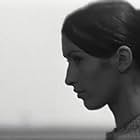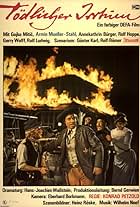Chingachgook is about to marry the daughter of the Delaware chief, when the Hurons kidnap her. Chingachgook and his friend Deerslayer try to rescue her though white scalp hunters interfere u... Read allChingachgook is about to marry the daughter of the Delaware chief, when the Hurons kidnap her. Chingachgook and his friend Deerslayer try to rescue her though white scalp hunters interfere until the tribes unite against the palefaces.Chingachgook is about to marry the daughter of the Delaware chief, when the Hurons kidnap her. Chingachgook and his friend Deerslayer try to rescue her though white scalp hunters interfere until the tribes unite against the palefaces.
Adolf Peter Hoffmann
- Delewaren-Häuptling
- (as A.P. Hoffmann)
Heinz Klevenow Jr.
- Pfeilspitze - Hurone
- (as Heinz Klevenow)
Gisela Büttner
- Wahtawah
- (voice)
- (uncredited)
Günter Dornag
- Rider
- (uncredited)
Hermann Gall
- Herald
- (uncredited)
Leopoldine Kuhring
- Girl on Watch
- (uncredited)
Hans-Peter Pieper
- Chief of the Elders
- (uncredited)
Storyline
Did you know
- ConnectionsFeatured in Reel Injun (2009)
Featured review
Chingachgook, a Mohawk-born Delaware warrior, strives to rescue his wife Wahtawah from the clutches of an enemy camp of Huron. Joined by his trusted huntsman Deerslayer, the two confront racist pioneers and brutal British soldiers in their quest. Deerslayer catches the desire of Judith and thus the jealousy of her suitor, Harry. The action of the story functions like a seesaw, characters continuously traveling back and forth between a house on the lake and the Huron camp until the violent climax.
Richard Groschopp's last theatrically released film, Chingachgook, offers a fresh and entertaining look into a genre not familiar in the United States, an Indian adventure film with German actors and direction. Constructed in a manner very different to American films, it asserts a distinct foreign identity through an American locale. Its slow editing style allows the actors to perform in a large frame, emphasizing their movements like dance. Dance is an element of the film that is explored by the director. What appear as silly dances routines placed sporadically throughout the film are referential to the beautiful and precise choreography of fascist-era military parades and functions. This connection reveals Groschopp's ties to the propaganda films of Leni Riefenstahl, working early in his career as a cinematographer for the Olympia films of 1936. Due to Soviet occupation of East Germany at the time of the film's production, there are communist references apparent within the film as well. The Delaware and Huron communities are each portrayed as large, cohesive, units, shown in wide angle shots to reveal the magnitude of bodies, much like Vertov's and Eisenstein's work. A British attack on an Indian camp recalls images of the Odessa Steps scene from Battleship Potemkin(1925), an obvious reference to Soviet influence on the culture of East Germany.
Aesthetic beauty is important in the film. All of the well intending characters are physically attractive and are framed to reveal their sculpted and/ or shapely bodies. The personalities of the characters fall short of believable, however their interactions with one another are humorous due to their flatness. For example, Judith is attracted to Deerslayer's boyish good looks, and to show her attraction she trips in front of him and falls conveniently into his arms. The painfully stereotypical relationship these two characters have make the film worth watching in its own right, but the film has other merits. It is kinky melodrama with uber-German looking Indians fighting German speaking redcoats. The effect this film had on me (as a upstate New Yorker who grew up where the film takes place) was one that I encourage others to experience.
Richard Groschopp's last theatrically released film, Chingachgook, offers a fresh and entertaining look into a genre not familiar in the United States, an Indian adventure film with German actors and direction. Constructed in a manner very different to American films, it asserts a distinct foreign identity through an American locale. Its slow editing style allows the actors to perform in a large frame, emphasizing their movements like dance. Dance is an element of the film that is explored by the director. What appear as silly dances routines placed sporadically throughout the film are referential to the beautiful and precise choreography of fascist-era military parades and functions. This connection reveals Groschopp's ties to the propaganda films of Leni Riefenstahl, working early in his career as a cinematographer for the Olympia films of 1936. Due to Soviet occupation of East Germany at the time of the film's production, there are communist references apparent within the film as well. The Delaware and Huron communities are each portrayed as large, cohesive, units, shown in wide angle shots to reveal the magnitude of bodies, much like Vertov's and Eisenstein's work. A British attack on an Indian camp recalls images of the Odessa Steps scene from Battleship Potemkin(1925), an obvious reference to Soviet influence on the culture of East Germany.
Aesthetic beauty is important in the film. All of the well intending characters are physically attractive and are framed to reveal their sculpted and/ or shapely bodies. The personalities of the characters fall short of believable, however their interactions with one another are humorous due to their flatness. For example, Judith is attracted to Deerslayer's boyish good looks, and to show her attraction she trips in front of him and falls conveniently into his arms. The painfully stereotypical relationship these two characters have make the film worth watching in its own right, but the film has other merits. It is kinky melodrama with uber-German looking Indians fighting German speaking redcoats. The effect this film had on me (as a upstate New Yorker who grew up where the film takes place) was one that I encourage others to experience.
Details
- Runtime1 hour 32 minutes
- Sound mix
- Aspect ratio
- 2.35 : 1
Contribute to this page
Suggest an edit or add missing content

Top Gap
By what name was Chingachgook, die grosse Schlange (1967) officially released in Canada in English?
Answer






















